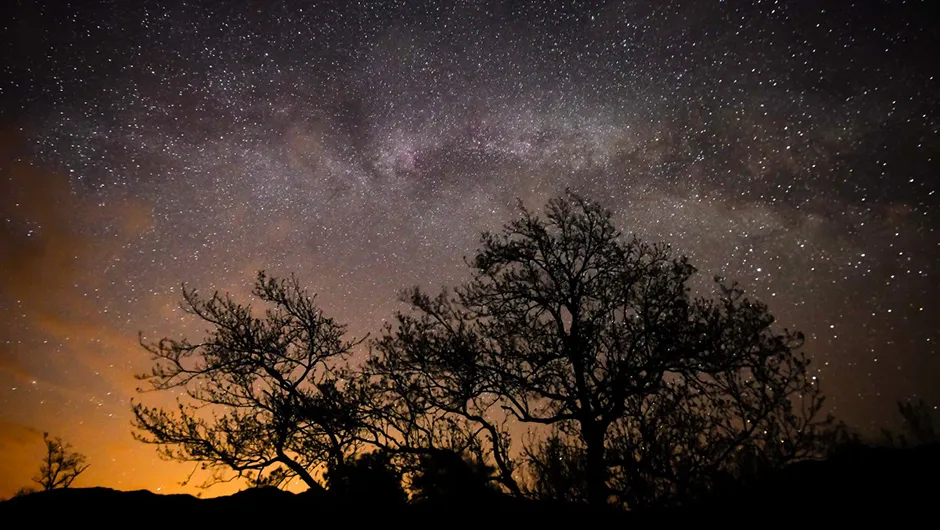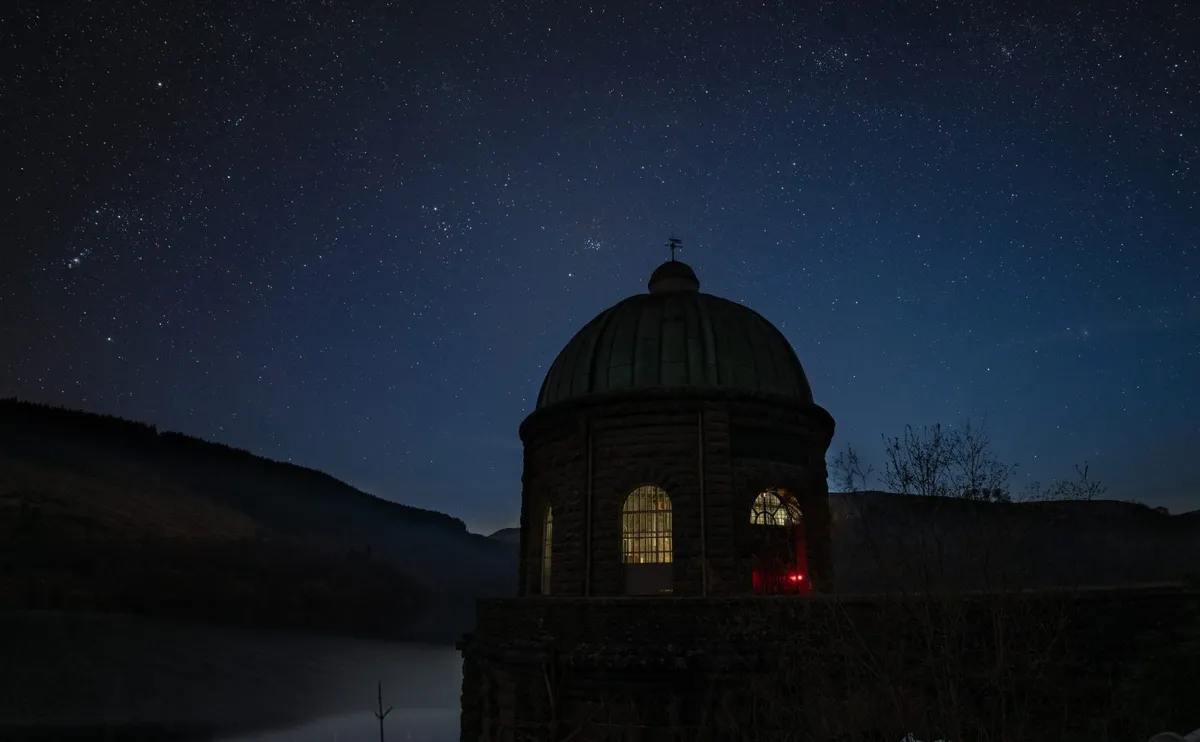The landscape of Wales offers dramatic vistas. Knowing the intense beauty of its grand mountains and valleys, the country has done much to ensure that its natural resources remain protected, including one so often ignored: its night skies.
Few other nations in the world have done as much to protect their dark skies as Wales. In 2015 Snowdonia became the third area in the country to receive endorsement from the International Dark Sky Association (IDA), following Brecon Beacons and Elan Valley.
Now nearly 18% of Wales’s skies are certified dark, more than any other country in the world. Wales is truly a dark-sky nation.
But this wasn’t always the case. A few years ago, the rangers at Snowdonia National Park noticed an insidious presence invading their park. Light pollution was beginning to encroach on their night skies.
“People walking in the mountains at night like the feeling of being in the middle of nowhere. But there was an orange dome of light below them. It does impact your enjoyment of being outside at night,” says Gethin Davies, ecosystems and climate change officer at Snowdonia National Park.
For more advice, read our guide on how to stargaze or our pick of the best places to stargaze in the UK.

The sky glow was not only affecting people’s enjoyment of the park, it was changing the behaviour of native bats, owls and other nocturnal animals.
As the sky glow began to encroach further into the park, they realised that something needed to be done.
The team decided to seek protection for their neglected night and turned to the IDA.
Since 2001 the IDA has been helping communities and natural spaces around the world to hold off light pollution and become Dark Sky Places, not by switching illuminations off, but using them more appropriately.
For the last few years the association has helped ensure the night sky throughout Wales is kept in the dark.
“By getting dark sky status as well as protecting wildlife and the environment, we’ve now created a base in mid-Wales for astronomers and their families to come on holiday,” says Les Fry from the Elan Valley Astronomical Society.
Fry and the rest of the society helped the privately owned Elan Valley gain dark-sky status a few months before Snowdonia.
The astronomers of the area realised that they had something special on the estate, and the status would not only help them protect their skies, but to share them.
“Wales has this huge central area where there are no lights,” says Fry. “Astronomy is something that can really flourish here.”
The regions are already well set up for tourism, but most visitors arrive in the summer months to take advantage of daytime activities.

As people learn what the Welsh nights have to offer, the nation is becoming a hub for astro tourism.
In the Brecon Beacons, which has had dark-sky status for over two years, the local tourism industry has learned to embrace the night.
“Bed and breakfasts are buying up telescopes and binoculars so their guests know what’s in the night sky,” says Huw James, who runs astronomy photography courses in the Brecon Beacons.
“Cottages and farms that offer accommodation will now rent telescopes too.”
With the equipment on hand, it’s easy to get up and go as soon as there’s a clear sky. Luckily, finding a good spot is just as easy.
“There are miles of roads throughout the National Parks where you can park up on the verge and have amazing panoramic views with dark skies,” says James.
To make it even easier there are specifically suggested spots for you to set up your scope and get observing without having to trek far away from a convenient car park.
Across Wales there are dozens of Dark Sky Discovery Sites that are too bright to gain accreditation from the IDA, but which are still excellent spots to get to know the night sky.
From these it should be dark enough to see Orion and other constellations, helping you to begin to find your way around the night sky.
But in Pembrokeshire and Rhondda Cynon Taf near Cardiff, there are several higher-class Discovery Sites where it is possible see the Milky Way.
“Discovery Sites are places that have good quality night skies that you can get to easily on public footpaths, with facilities close by such as toilets or a car park. They’re not necessarily the places that are the darkest, but they are easily accessible,” says Hannah Buck from the Pembrokeshire Coast National Park Authority.
These Discovery Sites are great for getting a start in stargazing and astrophotography.
With so many foregrounds to choose from, no two images need look the same. But if you’re looking to do some deep-sky observing and imaging it is possible to reach even darker skies than the observation spots in the IDA parks and reserves.

To truly get away from light pollution it might be necessary to hike off into the heart of the reserves.
The National Parks are always open and with a little effort you can find some brilliant places to image.
But venturing out in the dark, especially in the winter months, can be dangerous so you need to be ready.
As well as providing ample opportunity for astronomy, all of Wales’s National Parks offer events to take advantage of the dark skies.
As well as stargazing sessions run by local astronomy societies, there are many ways to take advantage of the lack of light pollution.
“In Pembrokeshire we’re looking to develop a whole range of things,” says Buck.
"From night-time bike rides, to bat discovery walks and glow-worm spotting, even fireside storytelling. When it’s the right time of year we can have some meteoric suppers!”
Such events have already been popular with visitors, but have also helped to promote the importance of keeping the night dark among locals as well.
As those that live in and around the reserves learn more about dark skies, they
are becoming more committed to ensuring their protection.
“We’re working with individual businesses and landowners,” says Ruth Coulthard from the Brecon Beacons International Dark Sky Reserve. “People have been quite proactive and receptive. Instead of having to go to them, they’ve come to us asking how to change their lighting.
"It’s not about turning off lights per se, it’s about the right light, in the right place, at the right time.”
For James, the coming years look promising. “In future we’re going to see light pollution in the Welsh National Parks going down,’ he says.
“In other sites around the world, including some of the more famous observing sites, we could see it go up. You might see a touch of sky glow on the horizon of wide shots but we’re seeing it slowly fade away here. It’s definitely less than we had 10 years ago.”
More of Wales is deciding to go dark. The Isle of Anglesey is beginning its bid to gain accreditation from the IDA, and along with the dozens of Dark Sky Discovery Sites throughout the nation, it is on its way to being a real destination for astronomers.
The dark sky nation is only going to get darker.
The best places to stargaze in Wales

Wales has huge regions with dark skies, but not all of them are easy to get to. Luckily, the Dark Sky Places and Discovery Sites provide good locations to get started
1
Snowdonia
With over 2000 square km of protected terrain, it’s likely that somewhere in Snowdonia National Park will have clear skies to take advantage of the darkness.
2
Elan Valley Estate
Elan Valley is located in Wales’s dark heart. Around the recognised Dark-Sky Park is several hundred square km of equally dark skies for intrepid astronomers to explore.
3
Pembrokeshire
While astronomers are stargazing, the rest of the family can still enjoy the National Park through nature and adventure activities in the region, both at night and during the day.
4
Brecon Beacons
Two years after receiving dark-sky status, the Brecon Beacons are now a hub for astro tourism. With rentable telescopes, classes and events, it’s easier than ever to get out under the stars here.
Find out more about dark skies in Wales
Elizabeth Pearson is BBC Sky at Night Magazine's News Editor. This article originally appeared in the April 2016 issue of BBC Sky at Night Magazine.
